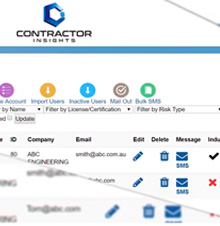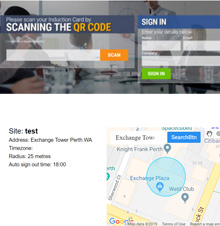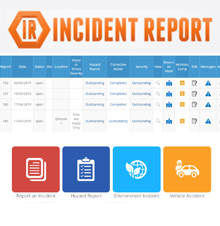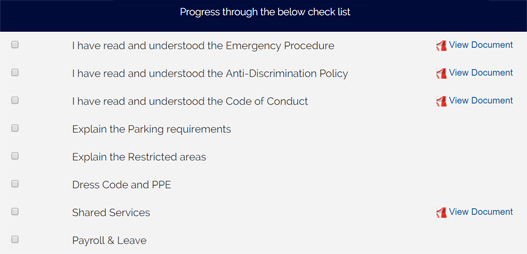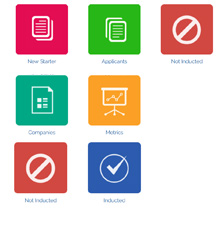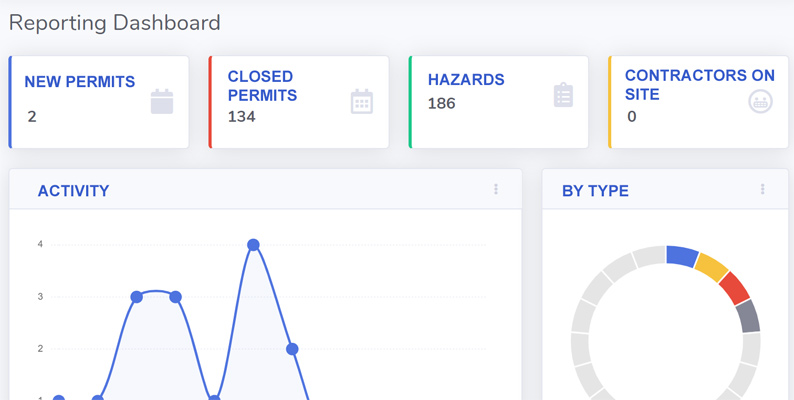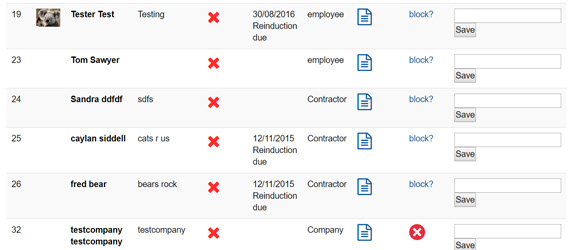What you need to know about Contractor Compliance Management
Online Induction >> Contractor Compliance ManagementPublished 20/09/2025
 Contractor compliance is a process of making sure that a contractor adheres to the organisation's requirements. In other words, it's a crucial aspect of contractor management focused on the extent to which a particular contractor performs his duties in conformance with the terms of the agreed contract.
From onboarding to exit procedures, on-site inspections to tax requirements - there are quite a few factors that go into creating an effective contractor risk mitigation program for any organization. Any organization looking to work with independent contractors needs to make sure that they understand all relevant laws and regulations pertaining to those localities, as well as proper onboarding carteridge methods that will help maintain compliance throughout checkerboarding periods of different roles within enterprise structures.
Contractor compliance is a process of making sure that a contractor adheres to the organisation's requirements. In other words, it's a crucial aspect of contractor management focused on the extent to which a particular contractor performs his duties in conformance with the terms of the agreed contract.
From onboarding to exit procedures, on-site inspections to tax requirements - there are quite a few factors that go into creating an effective contractor risk mitigation program for any organization. Any organization looking to work with independent contractors needs to make sure that they understand all relevant laws and regulations pertaining to those localities, as well as proper onboarding carteridge methods that will help maintain compliance throughout checkerboarding periods of different roles within enterprise structures.
The main objectives of contractor compliance are to reduce insurance liabilities, financial risks, safety risks in the workplace, and legal risks, to both the organisation and staff. You are also likely to experience a reduction in operating costs, an overall boost in productivity and increased contractor retention.
This forms a core part of the contractor management process and typically first begins with a contractor induction.
Reducing the compliance risks for contractors in your workplace
A contractor could potentially introduce any number of risks to your organisational operations while they are working on site which in turn becomes your risk to manage and mitigate. This might begin with any business or job activity involving any contractor, vendor, supplier, or service provider engaged by an organisation. The poor compliance outcome could mean damages, losses and accidents caused by contractors working at your workplace, site or project and associated with your business operations regardless of the actual fault or liability.
Contractor Prequalification is another major area where contractor compliance checks are important. As part of this process, a full risk and safety review is undertaken to ensure the contractor is prequalified to be engaged by the organisation in the first place.
Establishing a centralised contractor compliance system criteria
Contractor compliance is all about minimising the risk exposure to the organisation through improved contractor management. Contractor compliance criteria needs to be thorough and complete and should involve relevant stakeholders. Contractors need to fully agree to and understand all compliance obligations before they begin their job task, activity or project and start working on site at your workplace.
What sort of areas contractors and subcontracting companies need to be compliant on?
 Contractor compliance is typically fundamental and without it, both the organisation and the lives of the employees are at greater risk. It can be a complex and challenging task to manage contractors, especially when engaging large numbers of them on site. So it's critical to ensure conformity with all the legal obligations, site specific policies and procedures and to maintain any necessary documentation. Contractors must be competent enough and have the following:
Contractor compliance is typically fundamental and without it, both the organisation and the lives of the employees are at greater risk. It can be a complex and challenging task to manage contractors, especially when engaging large numbers of them on site. So it's critical to ensure conformity with all the legal obligations, site specific policies and procedures and to maintain any necessary documentation. Contractors must be competent enough and have the following:
 Licenses
Licenses Insurances
Insurances  Evidence of training
Evidence of training  Certifications they hold
Certifications they hold Incident and safety history and performance
Incident and safety history and performance Permits to Work
Permits to Work The safety systems and procedures they have in place
The safety systems and procedures they have in place
Testing the knowledge of contractors around important site and organisation policies and procedures is done via assessments on compliance, usually focusing on the above factors and verification of new employees hired by a subcontractor, to ensure they also meet the qualification requirements. An organisation commonly will prequalify contractors, ensure contractor document expiries are renewed (i.e. insurances, tickets or licenses) and continuously monitor their operations, site access (how many contractors are on site right now?) all as part of the process of developing and implementing an effective and efficient contractor compliance system. Contractor compliance is a very essential practice as non-compliant contractors and subcontractors can expose the organisation to financial and liability risks. The risks increase when the contractors do not complete the created safety training (such as a contractor induction), that can lead to accidents in the workplace (injury incidents, property damage, near miss incidents, security incidents and environmental accidents). Part of contractor compliance can also include managing toolbox talks, a job safety analysis (JSA) and safe work method statements.
See an example contractor compliance management system for the full life cycle from start to finish from contractor induction and prequalification through to contractor management tools

Guide for setting up a contractor compliance management system
 Using contractor compliance software
Using contractor compliance softwareUsing a contractor compliance tool you can centralise and manage your entire contractor management process. From initial prequalification through to induction, prescreening, insurance uploads, automatic compliance reminders, checks individual licenses through to performance management and subcontractors.
Sample contractor Compliance Steps

In this sample contractor compliance workflow, the contractor management process consists of prequalification and induction through to contractor performance review
Common areas you would manage
A common life cycle of contractor compliance management starts with contractor prequalification of a contracting company. Examining their safety and risk history in order to verify and validate all their materials, previous safety performance and processes and systems in place for managing the risks relating to their job task or activity. This is followed by a contractor induction for all their staff working at your organisation to ensure they understand and acknowledge everything needed in order to work safe.
Once the contractors are engaged and working with your organisation, the next phase might be tracking which contractors are currently on site right now with a contractor sign in app. This can ensure contractors have extra compliance checks upon arrival on site (i.e. what happens if their insurance expires on the day they arrive at your workplace?). Annual safety reviews of contractor performance, re-inductions, contractor offboarding, contractor ratings, contractor risk management and classifying contractors by risk type are all additional areas in the contractor compliance management workflow.
- Contractor prequalification
- Contractor induction for all contractor staff
- Subcontractor prequalification and induction
- Classification by risk level (high risk construction tasks? low risk worker?)
- Acknowledgement and tested they understand important safety and site policies and procedures
- Site access management, which contractors are on site right now and are they compliant
- Contractor performance management
- Contractor ratings
- Ongoing risk management
- Re-inductions
- Safety reviews
- Offboarding contractors
Many of these areas might be driven through your contractor portal and your overall contractor management software.
The Importance of a Good Contractor Compliance Management System
 Effective contractor compliance is an important system every company should implement for various reasons. The monitoring of all subcontractors through different processes helps maintain legal industry standards, protect confidential information from disclosure and ultimately enhance safety among other contractual commitments. While there's no one size fits all strategy when it comes to managing compliance around contractors; there are certain considerations that can ensure success as well as help prevent costly problems down the road such as regulatory fines or careless handling of data.
Effective contractor compliance is an important system every company should implement for various reasons. The monitoring of all subcontractors through different processes helps maintain legal industry standards, protect confidential information from disclosure and ultimately enhance safety among other contractual commitments. While there's no one size fits all strategy when it comes to managing compliance around contractors; there are certain considerations that can ensure success as well as help prevent costly problems down the road such as regulatory fines or careless handling of data.
Contractor classification has become increasingly important for understanding how much oversight is required depending upon where services are rendered - particularly matters related too taxes earned & withheld from payments associated with particular projects - so it's crucial for managers and leaders inside these organizations keep up-to-date on all such changes by gaining knowledge through webinars, workshops or virtual training courses
understanding whether your newly acquired contractors will require specialized training or background checks- both which usually require additional paperwork and manpower investment upfront. Furthermore, you must also consider how these requirements fit within any existing safety protocols while regularly assessing whether their work performance meets specific organizational goals or corporate policies before signing off any project deliverables. As part of this process you should make sure critical documents are filed with each contract so they could be easily accessed if needed in case audits happen alongside keeping track IT configuration changes made along the way by said subcontractors for extra security measures.
Contractor Compliance Tracking
One of the biggest challenges when it comes to contractor compliance is keeping track of renewals, expiry dates, checking current compliance activity in real-time and a forward view of any potential gaps or issues ahead of them being problems for your site or workplace. The implications of getting any of these areas wrong could be devasting for the site., especially if contractors are undertaking works when not properly vetted to do so in the first place. Having an overarching view of contractor compliance could be the difference between a non conformance or not and even prevent an incident from occurring by having the proper compliance checks in place and centralising all compliance management of contractors across all work locations. It can be challenging for some departments to do this when often large workplaces and facilities might have many different responsible persons independently engaging contractors to come in on site without their knowledge. This is where the centralised approach works best to resolve this.- tracking contractor renewals
- asset management tracking
- compliance checks
- matched to job task or activity
Contractor Compliance Areas
There are many areas to contractor compliance that you might need to track and manage:- Insurances: does the contractor have and maintain the right and correct level of cover for the nature of work they are undertaking?
- Evidence of training: does the contracting company and the staff that are arriving on site hold the correct evidence of training and licenses for that job task or activity?
- Systems in place: what systems do they have in place for managing incidents and hazards and do they maintain a registry? Do they carry out audits and inspections?
- Processes and Procedures: what processes and procedures do they have in place around safety, risks management, staff and business?
- Regulatory activity: have that had any breaches or notifiable incidents?
Why it's important to manage these areas online before they start working on site?
 Online inductions have emerged to be an effective method of introducing contractor compliance regulations and policies. Contractors are inducted on the relevant safety regulations and the legal aspects of the project in order for them to work safely, ensure the safety of their co-workers and ensure they remain compliant at all times both individually and as a contracting organisation. These online inductions benefit an organisation during the collection of the contractor's documents by easily tracking the contractors who have gone through their inductions and who haven't. Also, all the completed inductions are kept in one place ensuring the recorded documents can be easily accessed.
Online inductions have emerged to be an effective method of introducing contractor compliance regulations and policies. Contractors are inducted on the relevant safety regulations and the legal aspects of the project in order for them to work safely, ensure the safety of their co-workers and ensure they remain compliant at all times both individually and as a contracting organisation. These online inductions benefit an organisation during the collection of the contractor's documents by easily tracking the contractors who have gone through their inductions and who haven't. Also, all the completed inductions are kept in one place ensuring the recorded documents can be easily accessed.
Online contractor management systems are common platforms for engaging new and returning contractors and making sure they pass through a comprehensive and consistent contractor management process.
In conclusion, it's worth knowing that every aspect of the process of contracting needs strong attention to detail and patience. An effective contractor compliance management system will ensure that the contractor meets the requirements of your organisation as consistently and efficiently as possible. Keep the employees safe, reduce risks in the workplace, and also save on valuable resources, time, and money with contractor compliance management.



